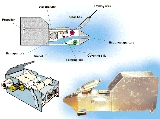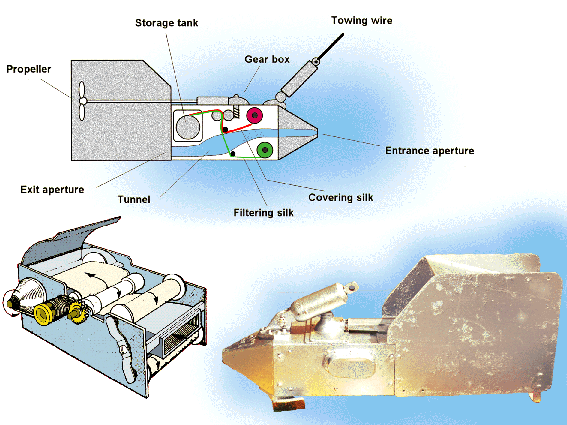
Continuous Plankton Recorder
Encyclopedia
The Continuous Plankton Recorder (CPR) survey is one of the longest running marine biological
monitoring programmes in the world. Started in 1931 by Sir Alister Hardy, the CPR has provided marine scientists with their only measure of plankton
communities on a pan-oceanic scale. Today the CPR survey is operated by the Sir Alister Hardy Foundation for Ocean Science (SAHFOS), located in Plymouth
, UK. Uniquely, the CPR survey’s methods of sampling and plankton analysis remain unchanged since 1948, providing a spatio-temporally comprehensive > 60 year record of marine plankton dynamics.
, Baltic
and North Sea
s and in freshwater lakes. However, SAHFOS CPR sampling primarily focuses on the northwest European shelf and the Northeast and Northwest Atlantic, with these regions undergoing monthly sampling; regular sampling is also now carried out in the North Pacific. Additionally, sister CPR surveys, not conducted by SAHFOS but using similar methodology, are operated from the USA and Australia
.
 The CPR is towed at a depth of approximately 10 metres. Water passes through the CPR and plankton are filtered onto a slow-moving band of silk
The CPR is towed at a depth of approximately 10 metres. Water passes through the CPR and plankton are filtered onto a slow-moving band of silk
(270 micrometre mesh size) and covered by a second silk. The silks and plankton are then spooled into a storage tank containing formalin. On return to the laboratory, the silk is removed from the mechanism and divided into samples representing 10 nautical miles (18.5 km) of tow.
CPR samples are analyzed in two ways. Firstly, the Phytoplankton Colour Index (PCI) is determined for each sample. The colour of the silk is evaluated against a standard colour chart and given a 'green-ness' value based on the visual discoloration of the CPR silk produced by green chlorophyll
pigments; the PCI is a semiquantitative estimate of phytoplankton biomass. In this way the PCI takes into account the chloroplasts of broken cells and small phytoplankton
which cannot be counted during the microscopic analysis stage. After determination of the PCI, microscopic analysis is undertaken for each sample, and individual phytoplankton
and zooplankton
taxa are identified and counted. Nearly 500 phyto- and zooplankton taxa have been identified on CPR samples since 1948.
Marine biology
Marine biology is the scientific study of organisms in the ocean or other marine or brackish bodies of water. Given that in biology many phyla, families and genera have some species that live in the sea and others that live on land, marine biology classifies species based on the environment rather...
monitoring programmes in the world. Started in 1931 by Sir Alister Hardy, the CPR has provided marine scientists with their only measure of plankton
Plankton
Plankton are any drifting organisms that inhabit the pelagic zone of oceans, seas, or bodies of fresh water. That is, plankton are defined by their ecological niche rather than phylogenetic or taxonomic classification...
communities on a pan-oceanic scale. Today the CPR survey is operated by the Sir Alister Hardy Foundation for Ocean Science (SAHFOS), located in Plymouth
Plymouth
Plymouth is a city and unitary authority area on the coast of Devon, England, about south-west of London. It is built between the mouths of the rivers Plym to the east and Tamar to the west, where they join Plymouth Sound...
, UK. Uniquely, the CPR survey’s methods of sampling and plankton analysis remain unchanged since 1948, providing a spatio-temporally comprehensive > 60 year record of marine plankton dynamics.
Sampling and analysis
The CPR is a plankton sampling instrument designed to be towed from merchant ships, or ships of opportunity, on their normal sailings. As of December 31, 2007, CPRs have been towed a total of 5460042 nmi (10,111,997.8 km) by 278 ships since the survey’s inception. Recorders have been towed in all oceans of the world, the MediterraneanMediterranean Sea
The Mediterranean Sea is a sea connected to the Atlantic Ocean surrounded by the Mediterranean region and almost completely enclosed by land: on the north by Anatolia and Europe, on the south by North Africa, and on the east by the Levant...
, Baltic
Baltic Sea
The Baltic Sea is a brackish mediterranean sea located in Northern Europe, from 53°N to 66°N latitude and from 20°E to 26°E longitude. It is bounded by the Scandinavian Peninsula, the mainland of Europe, and the Danish islands. It drains into the Kattegat by way of the Øresund, the Great Belt and...
and North Sea
North Sea
In the southwest, beyond the Straits of Dover, the North Sea becomes the English Channel connecting to the Atlantic Ocean. In the east, it connects to the Baltic Sea via the Skagerrak and Kattegat, narrow straits that separate Denmark from Norway and Sweden respectively...
s and in freshwater lakes. However, SAHFOS CPR sampling primarily focuses on the northwest European shelf and the Northeast and Northwest Atlantic, with these regions undergoing monthly sampling; regular sampling is also now carried out in the North Pacific. Additionally, sister CPR surveys, not conducted by SAHFOS but using similar methodology, are operated from the USA and Australia
Australia
Australia , officially the Commonwealth of Australia, is a country in the Southern Hemisphere comprising the mainland of the Australian continent, the island of Tasmania, and numerous smaller islands in the Indian and Pacific Oceans. It is the world's sixth-largest country by total area...
.

Silk
Silk is a natural protein fiber, some forms of which can be woven into textiles. The best-known type of silk is obtained from the cocoons of the larvae of the mulberry silkworm Bombyx mori reared in captivity...
(270 micrometre mesh size) and covered by a second silk. The silks and plankton are then spooled into a storage tank containing formalin. On return to the laboratory, the silk is removed from the mechanism and divided into samples representing 10 nautical miles (18.5 km) of tow.
CPR samples are analyzed in two ways. Firstly, the Phytoplankton Colour Index (PCI) is determined for each sample. The colour of the silk is evaluated against a standard colour chart and given a 'green-ness' value based on the visual discoloration of the CPR silk produced by green chlorophyll
Chlorophyll
Chlorophyll is a green pigment found in almost all plants, algae, and cyanobacteria. Its name is derived from the Greek words χλωρος, chloros and φύλλον, phyllon . Chlorophyll is an extremely important biomolecule, critical in photosynthesis, which allows plants to obtain energy from light...
pigments; the PCI is a semiquantitative estimate of phytoplankton biomass. In this way the PCI takes into account the chloroplasts of broken cells and small phytoplankton
Phytoplankton
Phytoplankton are the autotrophic component of the plankton community. The name comes from the Greek words φυτόν , meaning "plant", and πλαγκτός , meaning "wanderer" or "drifter". Most phytoplankton are too small to be individually seen with the unaided eye...
which cannot be counted during the microscopic analysis stage. After determination of the PCI, microscopic analysis is undertaken for each sample, and individual phytoplankton
Phytoplankton
Phytoplankton are the autotrophic component of the plankton community. The name comes from the Greek words φυτόν , meaning "plant", and πλαγκτός , meaning "wanderer" or "drifter". Most phytoplankton are too small to be individually seen with the unaided eye...
and zooplankton
Zooplankton
Zooplankton are heterotrophic plankton. Plankton are organisms drifting in oceans, seas, and bodies of fresh water. The word "zooplankton" is derived from the Greek zoon , meaning "animal", and , meaning "wanderer" or "drifter"...
taxa are identified and counted. Nearly 500 phyto- and zooplankton taxa have been identified on CPR samples since 1948.
Ecological research
Due to its long time-series, comprehensive spatial coverage and methodological consistency, the Continuous Plankton Recorder survey is a unique ecological dataset which has provided invaluable insights into numerous aspects of plankton dynamics and ecology. Key areas of research include:- Climate changeClimate changeClimate change is a significant and lasting change in the statistical distribution of weather patterns over periods ranging from decades to millions of years. It may be a change in average weather conditions or the distribution of events around that average...
- BiodiversityBiodiversityBiodiversity is the degree of variation of life forms within a given ecosystem, biome, or an entire planet. Biodiversity is a measure of the health of ecosystems. Biodiversity is in part a function of climate. In terrestrial habitats, tropical regions are typically rich whereas polar regions...
and biogeographyBiogeographyBiogeography is the study of the distribution of species , organisms, and ecosystems in space and through geological time. Organisms and biological communities vary in a highly regular fashion along geographic gradients of latitude, elevation, isolation and habitat area... - EutrophicationEutrophicationEutrophication or more precisely hypertrophication, is the movement of a body of water′s trophic status in the direction of increasing plant biomass, by the addition of artificial or natural substances, such as nitrates and phosphates, through fertilizers or sewage, to an aquatic system...
- Harmful Algal Blooms (HABs)
- Fisheries investigations
- Plankton ecology
- TaxonomyTaxonomyTaxonomy is the science of identifying and naming species, and arranging them into a classification. The field of taxonomy, sometimes referred to as "biological taxonomy", revolves around the description and use of taxonomic units, known as taxa...
- Regime shiftRegime shiftRegime shifts is defined as rapid reorganizations of ecosystems from one relatively stable state to another. The idea of a regime shift was first used in investigations of freshwater and terrestrial systems. It is now been used for marine and estuarine systems to describe rapid shifts between two...
s - Non-indigenous species

